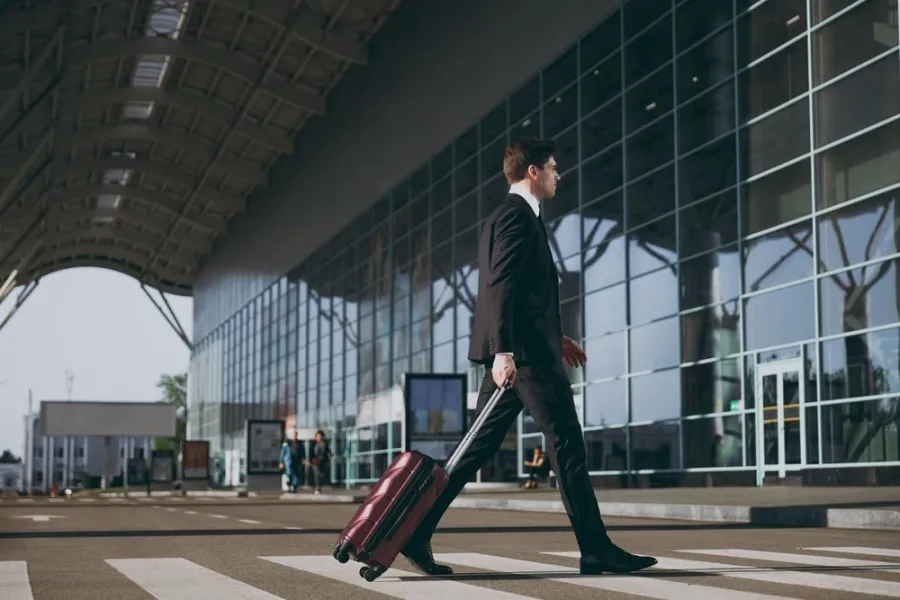Change language
How early should you be at the airport? A traveler’s guide
February 10, 2025

We’ve all been there—standing in a long security line, constantly checking the time, wondering if we’ll make it to the gate before boarding closes. Or, on the flip side, arriving way too early, only to sit at the terminal for hours, scrolling through our phones and regretting that extra hour of sleep we could have had.
So, how early should you really get to the airport?
Is the „arrive three hours before your flight" rule always necessary, or can you sometimes get away with cutting it closer? The truth is, it depends.
How early should you be at the airport?
The recommended time to arrive at the airport depends on several factors, including your destination, airline, and whether you’re checking baggage. Here are general guidelines:
Domestic flights (within the same country)
- Without checked baggage: arrive at least 1.5 to 2 hours before departure.
- With checked baggage: arrive at least 2 hours before departure.
International flights
Most airlines recommend arriving at least 3 hours before departure to allow time for check-in, security, and immigration procedures.
Special considerations
- Large or busy airports (e.g., JFK, LAX, Heathrow): add an extra 30 minutes to 1 hour.
- Peak travel times (holidays, weekends): arrive 30–60 minutes earlier.
- Traveling with children or special needs passengers: arrive earlier to accommodate extra time needed.
- Flying with budget airlines: some low-cost carriers have stricter cut-off times for check-in and boarding.
Security & Check-in deadlines
- Check your airline’s cut-off times for check-in and boarding, as they vary by carrier.
- Most check-in counters close 45–60 minutes before departure (earlier for international flights).
- Boarding usually starts 30–45 minutes before departure.
Best practice: If unsure, check with your airline and aim to be at the airport earlier rather than later to avoid stress.
Factors influencing your arrival time: domestic vs international flights
The time you need to arrive at the airport before your flight depends on various factors, with the most significant being whether your flight is domestic or international. Below are key considerations for each:
Domestic flights (within the same country)
Recommended arrival time: 1.5 to 2 hours before departure
Factors to consider:
- Security screening time: domestic security checks are typically faster than international ones. TSA PreCheck (in the U.S.) or similar programs can reduce wait times significantly.
- Checked vs. Carry-On Luggage: if you have only carry-on luggage, you can save time by checking in online and heading straight to security. If you need to check baggage, allow extra time for potential lines at the airline counter.
- Airport size & traffic: smaller regional airports may require less time, while major hubs (e.g., LAX, JFK, Heathrow, biggest airports in the USA) might have longer security lines and more congestion.
- Airline boarding policy: some airlines have strict cut-off times for check-in and boarding (especially budget carriers).
- Time of Day & Seasonality: rush hours (morning & evening) and holiday seasons can mean longer lines.
Best practice: arriving 1.5 to 2 hours before your domestic flight gives you enough time for check-in, security screening, and getting to your gate with minimal stress.
International flights (crossing borders)
Recommended arrival time: 3 hours before departure
Factors to consider:
- Additional check-in & security procedures: international flights often require passport verification and sometimes extra security screenings.
- Immigration & customs: you may need to go through customs or immigration before departure, which can take extra time.
- Airline & destination-specific requirements: some airlines or countries require additional documentation checks, such as visas, vaccination proof, or travel authorizations.
- Longer boarding process: international flights typically have larger aircraft and longer boarding times.
- Baggage drop-off times: international baggage screening can take longer, so check-in counters may close earlier than for domestic flights.
- Peak travel seasons & crowded airports: international travel during holidays, summer, and peak tourism periods may result in longer wait times at check-in and security.
Best practice: arriving at least 3 hours before your international flight ensures enough time for check-in, security, immigration, and unforeseen delays.
The Influence of airline, airport size, and season on arrival time
When deciding how early you should arrive at the airport, three key factors significantly impact your timing: the airline you’re flying with, the size of the airport, and the season or time of year. Here’s how each of these elements affects your travel plans:
1. The airline’s policies and procedures
Different airlines have different rules for check-in, baggage drop, and boarding deadlines.
- Full-service airlines (like Delta, Emirates, British Airways) tend to have longer check-in and security procedures, especially for international flights.
- Budget airlines (like Ryanair, Spirit, Wizz Air) are often stricter with check-in and boarding times. Many close their check-in counters earlier and charge extra fees if you miss deadlines.
- Hub vs. non-hub flights – If you’re flying with an airline from its main hub (e.g., Lufthansa at Frankfurt or American Airlines at Dallas), expect more traffic and longer security lines.
Tip: always check your airline’s official recommendation for airport arrival time, especially for international flights where check-in may close 60 minutes or more before departure.
2. Airport size and traffic
The time needed to get through security and reach your gate can vary dramatically based on the airport’s size and layout.
- Smaller airports (e.g., San Diego, Vienna, Helsinki) usually have shorter security lines and less walking distance to gates. You can often arrive closer to departure time.
- Large international airports (e.g., JFK, Heathrow, Dubai, LAX) have multiple terminals, long security lines, and potential shuttle/train transfers between gates, requiring more time.
- Busy hub airports (e.g., Frankfurt, Chicago O’Hare, Istanbul) have high passenger volume and frequent delays, so plan for extra time.
Tip: if flying from a large or unfamiliar airport, allow an additional 30–60 minutes beyond standard recommendations.
3. Season and peak travel times
The time of year also affects how early you should arrive at the airport:
- Peak seasons (summer, winter holidays, Thanksgiving, Easter) see massive crowds, long lines at security and check-in, and frequent delays.
- Early morning and evening rush hours (5–9 AM & 5–8 PM) typically mean longer security wait times.
- Bad weather seasons (winter snowstorms, monsoon season, hurricane season) can cause delays, so arriving earlier allows for rescheduling options if needed.
Tip: during peak travel periods, arrive 30–60 minutes earlier than usual to accommodate longer queues and potential delays.
If you arrive at the airport late and miss your flight, the airline is not responsible unless it was due to their delay. However, if you miss a connecting flight due to an airline-caused delay, you may be entitled to compensation or rebooking.
How to allocate time for check-in, security, and boarding process
To ensure a smooth airport experience, it's important to properly allocate time for each stage of the pre-flight process: check-in, security screening, and boarding. Arriving at the airport early enough helps prevent stress, missed flights, or last-minute rushes. Here's how to manage your time effectively:
Check-in and baggage drop: time needed: 20–45 minutes
Check-in and baggage drop typically take 20–45 minutes, longer for international flights, depending on factors like online vs. airport check-in, airline policies, baggage type, and airport congestion. Online check-in allows passengers with carry-on luggage to proceed directly to security, while those with checked bags must still queue at the bag drop.
Budget airlines (e.g., Ryanair, Wizz Air) enforce strict check-in deadlines, often closing counters 60 minutes before departure, whereas full-service carriers (e.g., Delta, Emirates) may allow check-in up to 45–60 minutes before departure. Passengers with oversized or special baggage should expect additional wait times, and peak travel hours or large airports may further extend queues.
Security screening: time needed: 10–45 minutes
Smaller airports generally have shorter lines, while major hubs like LAX, JFK, and Heathrow experience longer waits, especially during peak hours (5–9 AM and 5–8 PM) and busy travel seasons such as holidays and summer. Travelers should anticipate longer security queues during these periods and plan accordingly.
Boarding process: time needed: 15–45 minutes
- Most airlines start boarding 30–45 minutes before departure.
- Boarding gates close 10–20 minutes before takeoff (this varies by airline).
- Larger planes (long-haul flights, wide-body aircraft) start boarding earlier due to more passengers and stricter time management.
Read more about how do flight classes work and what benefits does each offer!
Tips to streamline your airport experience and reduce waiting time
- Save time by checking in online before arriving at the airport, allowing you to bypass check-in counters if you have only carry-on luggage
- Follow TSA and international security rules by keeping liquids under 100ml (3.4 oz) in a clear, resealable bag, and placing electronics in an easily accessible compartment.
- Avoid lines with families or large groups, as they typically take longer, and look for dedicated lanes for TSA PreCheck, priority travelers, or business class passengers.
- Skip baggage drop and baggage claim by traveling light with a carry-on that meets airline size requirements.
- Have your boarding pass and ID ready, remove belts and metal items in advance, and wear easy-to-remove shoes to speed up the screening process.
By planning ahead and considering these factors, you can reduce stress and avoid unnecessary delays at the airport. Safe travels!
More travel blog recommendations

Μετατρέψτε την καθυστερημένη, ακυρωμένη ή υπερκλεισμένη πτήση σας σε αποζημίωση έως και 600€!
Αποζημίωση για καθυστερημένη πτήση ακυρώθηκε
Επιστροφή χρημάτων για ακυρωμένη καθυστερημένη πτήση
Αποζημίωση πτήσης
©2025 AirClaim.com - Όλα τα δικαιώματα διατηρούνται Air Claim SA - Bdul. Pipera 1/Vi Bl. HYPERION TOWERS Et. 3 SP. BIR. 3 Cod 077190, Voluntari, Ilfov, Ρουμανία




















